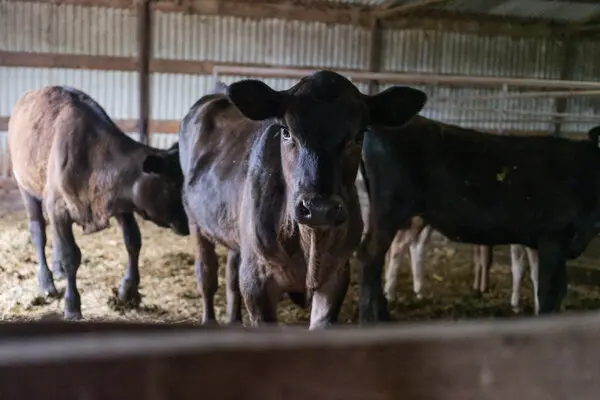How Does Bird Flu Spread in Cows? Experiment Yields Some ‘Good News.’
Scientists say that findings from a small experiment lend hope the outbreak among dairy cattle can potentially be contained.

Scientists have been baffled by how influenza transmits from one animal to another ever since they found that American cows were infected with it earlier this year. An experiment conducted in Germany and Kansas has partially resolved the mystery.
Researchers were unable to locate any proof that the virus may spread through respiratory infections. According to Kansas State University virologist Juergen Richt, who co-led the study, the findings indicate that the virus primarily spreads through contaminated milking machines.
Dr. Richt stated in an interview that the findings gave optimism that the outbreak could be stopped before the virus changed into a form that would be easier for people to spread among themselves.
Dr. Richt stated, “I think this is good news that we can probably control it easier than people thought.” “Hopefully, we can now take it out by giving it a kick to the behind.”
The results are still pending publication in a peer-reviewed scientific journal or internet release.
Not participating in the latest study, Seema Lakdawala, an Emory University virologist studying the virus on dairy farms, issued a warning: stopping the virus’s spread will necessitate significant adjustments to the way cows are milked.
“I think it’s fantastic that the results are being released,” she remarked. “But there’s a serious logistical issue here.”
Veterinarians started seeing inexplicable drops in milk output in specific cows in January. To be tested, they sent samples to the Department of Agriculture. The department declared in March that a fatal influenza virus that is common in birds was present in milk from cows in Kansas, New Mexico, and Texas. Additionally, swabs extracted from the mouth of a Texas cow contained the virus.
132 herds in 12 states have tested positive for the virus since then. After experiencing a decline in milk output, most cows recover; nevertheless, some have died or were put to death because they were not making progress.
It has long been recognized by researchers that certain influenza virus strains can shed into milk and infect mammary cells in udders. However, they had never witnessed a bird flu outbreak in cows like the one that is occurring this year.
Only three Americans have been affected by the cows, according to reports from state or federal authorities. Two of the affected farm laborers experienced pink eye, or conjunctivitis. Together with other respiratory symptoms, the third victim also had a cough.
Scientists were perplexed by the virus’s quick proliferation among cows. The fact that the virus exploited the method used on vast farms to milk cows could be one reason for its spread. The teats of a cow are cleaned, then manually squeezed to release a few squirts before four tubes, or claws, are attached. The worker takes off the claw and puts it on the next cow once it has finished extracting the milk. Before a claw is cleaned, it is usually used on hundreds of cows.
Dr. Lakdawala and her associates discovered that the influenza virus could survive on a claw for several hours in a different study that was released on Wednesday.
Additionally, scientists are concerned that the virus could be transmitted by the cows as a respiratory illness. When a cow had the virus in its respiratory system, it would cough or breathe out droplets. The droplets could be inhaled by other cows or transferred by physical touch.
Should that be the case, cows reared for meat instead of milk could potentially be infected by the virus. Additionally, it might make it easier for the infection to spread among people.
Together with German researchers, Dr. Richt and his Kansas colleagues conducted studies in which they purposefully infected cows in May. The two groups manage top-notch biosecurity facilities large enough to accommodate cows.
In the Friedrich-Loeffler-Institut in Greifswald, Germany, Martin Beer and associates administered the virus intraperitoneally (IV) to the teats of three nursing cows. The animals showed clinical indications of infection within two days, which were similar to what has been seen on farms: fevers, appetite loss, and much lower milk production.
Their milk was thick when it was produced. Dr. Beer described it as “like yogurt coming out of the udder.”
Dr. Beer and his colleagues also injected cows with a different strain of the H5N1 bird flu virus to check if the strain in the cows differed noticeably from other strains infecting birds. The clinical indications of infection were the same in the cows.
Thus, anywhere that this virus is present in the environment, this can occur, according to Dr. Richt.
Additionally, Dr. Richt gave injections of the cattle flu to three non-lactating female cows and three male cows. His team chose to inject the viruses into the animals’ lips and noses as opposed to their udders.
The cows got mild illnesses, and for eight days they exuded the virus through their mouths and noses.
Three healthy cows that had not contracted the virus were housed in the same room as the sick cows two days following the infection. In order to determine whether the uninfected animals contracted the flu from the sick cows’ inhaled droplets or through direct contact with them, the scientists observed the animals over the period of 19 days.
Not one cow that was healthy fell ill. “Transmission was not observed,” Dr. Richt stated. “The virus isn’t acting in the same way as a normal respiratory influenza virus.”
He issued a warning, noting that just a small number of cows were engaged in the two tests’ outcomes. An early strain of the virus was also examined by the scientists. Since the virus has been changing as it has spread from animal to animal, scientists are unsure if more recent strains of the virus will behave more like respiratory illnesses.
Dr. Lakdawala stated that it is now even more urgent to stop the virus from spreading among dairy cows as a result of the recent findings from researchers in Germany and Kansas, which were in line with epidemiological studies.
That might be easier said than done, though. Farms would produce less milk if they cleaned the milking claws after every cow. It’s possible that the chemicals used to clean the claws find their way into the milk supply. “Bleach should not be added to milk,” Dr. Lakdawala declared.
She stated that it was essential to shield humans from the virus in addition to halting its transmission from cow to cow. “We want to prevent infection among these dairy workers,” she stated.
The cows stand on a platform in a normal milking parlor with their udders at eye level with the employees. If milk spills onto the platform, it could condense into droplets that could enter employees’ eyes or enter their lungs. Goggles and face shields are examples of personal protective equipment that could be used to stop that infection path.
Not only will dairy workers’ health be safeguarded, but the spread will be stopped. Additionally, it might keep the virus from having another chance to develop inside a human host and become more adapted to our species.
Dr. Richt stated, “You never know what happens with this virus in the future.”




